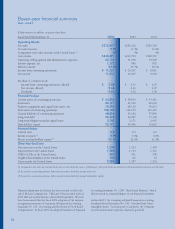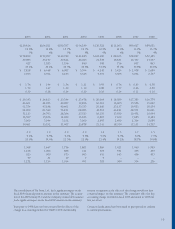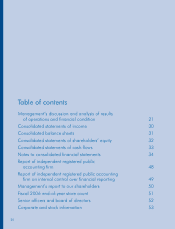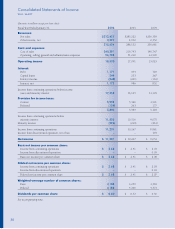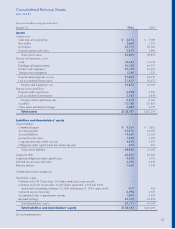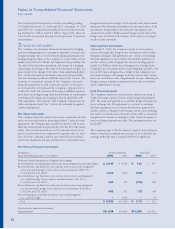Walmart 2006 Annual Report Download - page 30
Download and view the complete annual report
Please find page 30 of the 2006 Walmart annual report below. You can navigate through the pages in the report by either clicking on the pages listed below, or by using the keyword search tool below to find specific information within the annual report.
Management’s Discussion and Analysis of Results of Operations
and Financial Condition
WAL-MART
28
We enter into interest rate swaps to minimize the risks and costs
associated with fi nancing activities, as well as to maintain an appro-
priate mix of fi xed- and fl oating-rate debt. Our preference is to
maintain approximately 50% of our debt portfolio, including inter-
est rate swaps, in fl oating-rate debt. The swap agreements are
contracts to exchange fi xed- or variable-rates for variable- or fi xed-
interest rate payments periodically over the life of the instruments.
The aggregate fair value of these swaps was a gain of approximately
$133 million and $472 million at January 31, 2006 and 2005,
respectively. A hypothetical increase (or decrease) of 10% in inter-
est rates from the level in effect at January 31, 2006, would result
in a (loss) or gain in value of the swaps of ($103 million) or $104
million, respectively. A hypothetical increase (or decrease) of 10%
in interest rates from the level in effect at January 31, 2005, would
result in a (loss) or gain in value of the swaps of ($123 million) or
$126 million, respectively.
We hold currency swaps to hedge the foreign currency exchange
component of our net investments in the United Kingdom and
Japan. In addition, we hold a cross-currency swap which hedges
the foreign currency risk of debt denominated in currencies other
than the local currency. The aggregate fair value of these swaps at
January 31, 2006 and 2005, was a loss of $244 million and $169
million, respectively. A hypothetical 10% increase (or decrease) in
the foreign currency exchange rates underlying these swaps from
the market rate would result in a (loss) or gain in the value of the
swaps of ($96 million) and $78 million at January 31, 2006, and
($90 million) and $71 million at January 31, 2005. A hypothetical
10% change in interest rates underlying these swaps from the mar-
ket rates in effect at January 31, 2006 and 2005, would have an
insignifi cant impact on the value of the swaps.
In addition to currency swaps, we have designated debt of approxi-
mately £2.0 billion as of January 31, 2006 and 2005, as a hedge of
our net investment in the United Kingdom. At January 31, 2006,
a hypothetical 10% increase (or decrease) in value of the U.S. dol-
lar relative to the British pound would result in a gain (or loss) in
the value of the debt of $359 million. At January 31, 2005, a hypo-
thetical 10% increase (or decrease) in value of the U.S. dollar rela-
tive to the British pound would result in a gain (or loss) in the value
of the debt of $380 million. In addition, we have designated debt
of approximately ¥87.1 billion as of January 31, 2006 as a hedge of
our net investment in Japan. At January 31, 2006, a hypothetical
10% increase (or decrease) in value of the U.S. dollar relative to
the Japanese yen would result in a gain (or loss) in the value of
the debt of $75 million.
Summary of Critical Accounting Policies
Management strives to report the fi nancial results of the Company
in a clear and understandable manner, although in some cases
accounting and disclosure rules are complex and require us to use
technical terminology. In preparing our consolidated fi nancial state-
ments, we follow accounting principles generally accepted in the
United States. These principles require us to make certain estimates
and apply judgments that affect our fi nancial position and results of
operations as refl ected in our fi nancial statements. These judgments
and estimates are based on past events and expectations of future
outcomes. Actual results may differ from our estimates.
Management continually reviews its accounting policies, how they
are applied and how they are reported and disclosed in our fi nan-
cial statements. Following is a summary of our more signifi cant
accounting policies and how they are applied in preparation of the
fi nancial statements.
Inventories
We value our inventories at the lower of cost or market as deter-
mined primarily by the retail method of accounting, using the last-
in, fi rst-out (“LIFO”) method for substantially all merchandise
inventories in the United States, except SAM’S CLUB merchandise
and merchandise in our distribution warehouses, which is based on
the cost LIFO method. Inventories for international operations are
primarily valued by the retail method of accounting and are stated
using the fi rst-in, fi rst-out (“FIFO”) method.
Under the retail method, inventory is stated at cost, which is
determined by applying a cost-to-retail ratio to each merchan-
dise grouping’s retail value. The cost-to-retail ratio is based
on the fi scal year purchase activity. The retail method requires
management to make certain judgments and estimates that may
signifi cantly impact the ending inventory valuation at cost as
well as the amount of gross margin recognized. Judgments made
include the recording of markdowns used to sell through inven-
tory and shrinkage. Markdowns designated for clearance activity
are recorded at the time of the decision rather than at the point of
sale, when management determines the salability of inventory has
diminished. Factors considered in the determination of markdowns
include current and anticipated demand, customer preferences and
age of merchandise, as well as seasonal and fashion trends. Changes
in weather patterns and customer preferences related to fashion
trends could cause material changes in the amount and timing of
markdowns from year to year.
When necessary, the Company records a LIFO provision each quar-
ter for the estimated annual effect of infl ation, and these estimates
are adjusted to actual results determined at year-end. Our LIFO
provision is calculated based on inventory levels, markup rates and
internally generated retail price indices except for grocery items,
for which we use a consumer price index. At January 31, 2006
and 2005, our inventories valued at LIFO approximated those
inventories as if they were valued at FIFO.
The Company provides for estimated inventory losses (“shrink-
age”) between physical inventory counts on the basis of a per-
centage of sales. The provision is adjusted annually to refl ect the
historical trend of the actual physical inventory count results.
Historically, shrinkage has not been volatile.
Impairment of Assets
We evaluate long-lived assets other than goodwill for indicators of
impairment whenever events or changes in circumstances indicate
their carrying values may not be recoverable. Management’s judg-
ments regarding the existence of impairment indicators are based on
market conditions and our operational performance, such as operat-
ing income and cash fl ows. The variability of these factors depends
on a number of conditions, including uncertainty about future
events, and thus our accounting estimates may change from period


